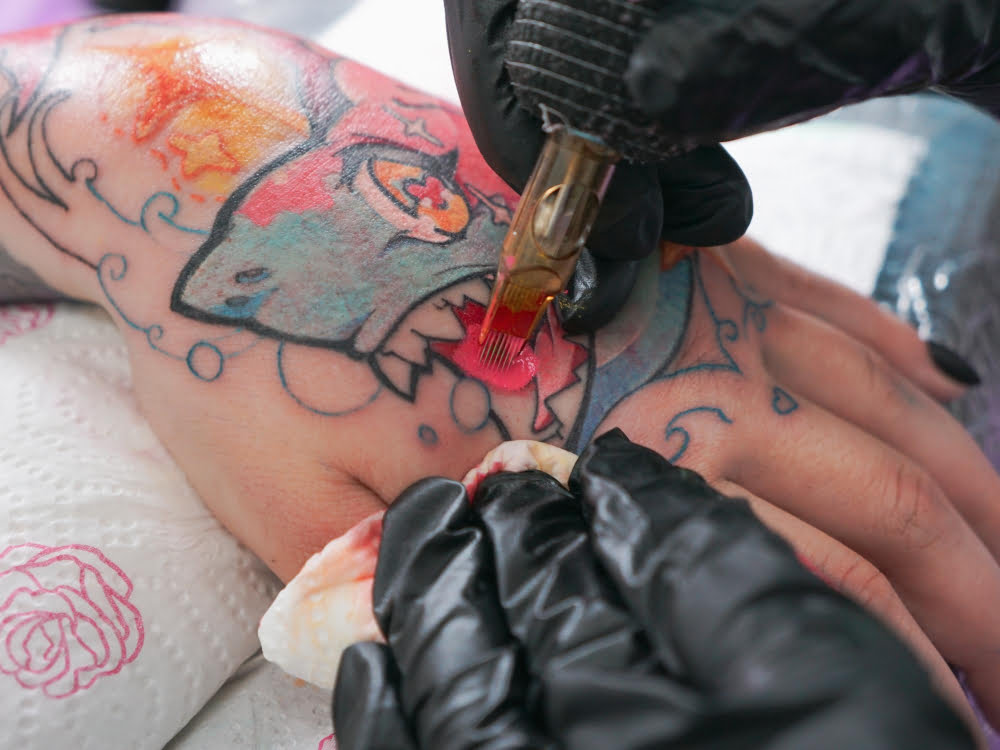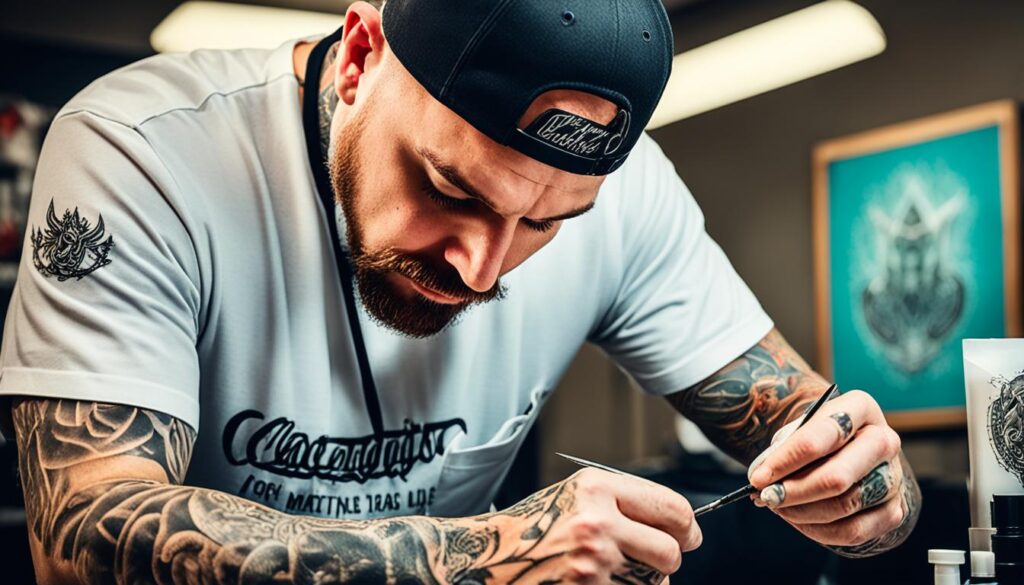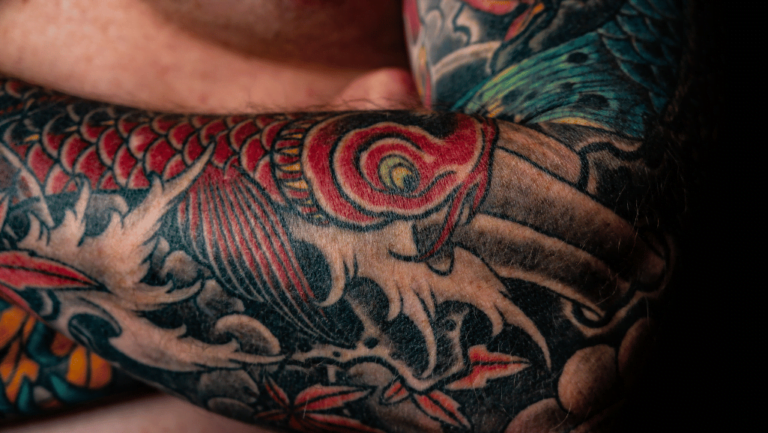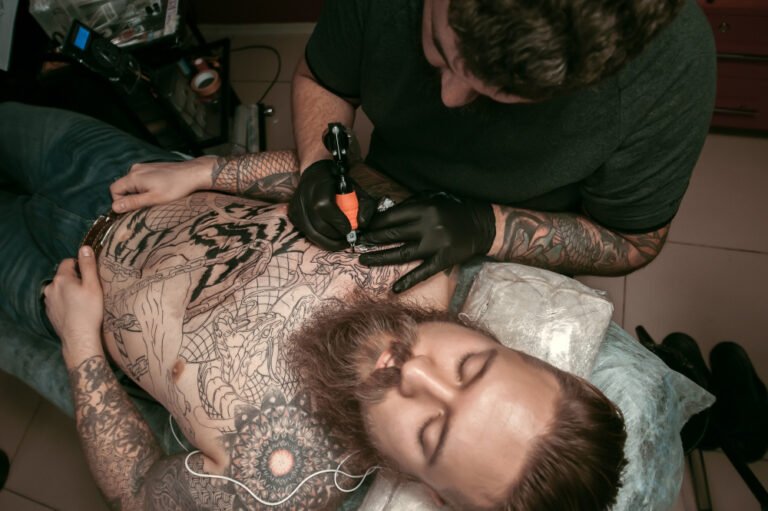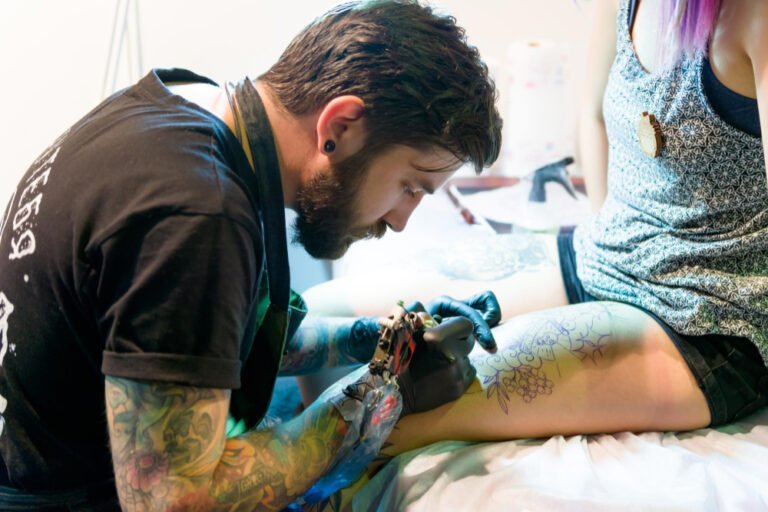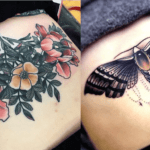Coloring a tattoo is more than just applying ink to skin; it is an art form that requires skill, precision, and creativity. Whether you are a seasoned tattoo artist or a beginner, mastering color blending techniques can elevate your tattoo designs to a whole new level. From selecting the right needle to blending and mixing tattoo ink, there are various aspects to consider for achieving stunning and seamless color transitions.
Key Takeaways:
- Proper needle selection and machine setup are crucial for successful tattoo color blending.
- Blending and mixing tattoo ink can help achieve desired colors or create unique shades.
- Precision and technique in color application contribute to smooth blending and transitions.
- Maintaining cleanliness throughout the process is essential for clarity and avoiding muddy mixes.
- Staying updated with trends, engaging with clients, and respecting cultural and ethical considerations enhance the tattoo coloring experience.
Setting Up your Tattoo Machine for Coloring – Needles
When it comes to coloring a tattoo, choosing the right needle is crucial for achieving the desired results. Different needles are designed for specific purposes, including color filling and shading. By understanding the different types and configurations of tattoo machine needles, you can ensure a successful coloring process.
Round Shader Needles for Color Filling and Basic Shading
Round shader needles are a popular choice for color filling and basic shading. These needles, which are typically grouped in tight circular configurations, allow for precise placement of color. The tight grouping creates a higher concentration of needles, resulting in even pigment distribution and smooth color saturation.
When setting up your tattoo machine for color filling, consider using round shader needles with a smaller diameter, such as 7 or 9. These sizes are ideal for detailed work and intricate designs. For basic shading, larger diameter round shaders, such as 14 or 18, can be used to achieve a broader coverage area.
Magnum Needles for Shading Larger Areas
When it comes to shading larger areas in a tattoo, magnum needles are the go-to choice. Magnum needles are available in different configurations, including weaved, stacked, and round/curved magnums. These configurations allow for different shading techniques, providing versatility and flexibility in achieving various shading effects.
Weaved magnum needles are widely used for finely detailed shading, while stacked magnum needles are suitable for smooth shading and blending. Round/curved magnums are popular for achieving both bold shading and softer gradients.
When selecting magnum needles for shading, pay attention to the needle size and configuration. Smaller needle sizes, such as 7 or 9, are commonly used for detailed shading, while larger sizes, such as 11 or 13, are preferred for shading larger areas.
Needle Configuration and Size for the Desired Effect
Whether you are color filling or shading, the configuration and size of your tattoo machine needle will greatly impact the overall outcome. Consider the effect you want to achieve and choose the needle configuration and size accordingly.
For a more concentrated and defined color application, opt for round shader needles with tighter groupings and smaller diameters. If you prefer a softer and more blended shading effect, magnum needles with larger diameters and different configurations will be more suitable.
Experimentation and practice with different needle configurations and sizes will help you find your preferred setup for coloring tattoos.
| Needle Type | Use | Benefits |
|---|---|---|
| Round Shader | Color filling and basic shading |
|
| Magnum | Shading larger areas |
|
Blending and Mixing Tattoo Ink for Color Application
When it comes to tattooing, achieving the perfect color can make all the difference in creating a stunning design. However, sometimes the ink in your collection may not provide the exact shade you need. This is where blending tattoo ink and mixing tattoo ink techniques come into play. By understanding the art of color blending, you can achieve the desired color or create custom colors to bring your tattoo designs to life.
Blending tattoo ink involves using sterile tools to combine different ink colors. This technique allows you to experiment with different ratios to achieve the perfect shade for your design. Whether you’re looking to create a subtle transition between colors or a vibrant and unique hue, blending tattoo ink gives you the creative freedom to customize the color palette for each tattoo.
Additionally, mixing tattoo ink allows you to create entirely new colors by combining different inks. This opens up a world of possibilities for creating custom hues that perfectly match your client’s vision or complement their existing tattoos. By mixing tattoo ink, you can showcase your artistic skills and offer a personalized touch to each client’s tattoo experience.
When blending and mixing tattoo ink, it’s important to prioritize cleanliness. Always use sterile tools and containers to avoid any contamination and ensure the integrity of the ink. Proper hygiene is crucial to prevent infection and maintain the safety of both the artist and the client. By adhering to these practices, you can confidently experiment with blending and mixing tattoo ink to achieve the desired color results.
Benefits of Blending and Mixing Tattoo Ink:
- Create custom colors that perfectly match the design
- Enhance color transitions and gradients for a realistic and visually appealing tattoo
- Offer unique and personalized tattoo experiences for your clients
- Showcase your artistic skills and creativity
| Blending and Mixing Tattoo Ink Tips |
|---|
| Vary the ratios of ink colors to achieve different shades |
| Use sterile tools and containers for blending and mixing tattoo ink |
| Experiment with different ink combinations to create custom colors |
| Stay organized and label your mixed inks for future reference |
| Take note of successful color blends to recreate them in the future |
Blending and mixing tattoo ink allows you to unleash your creativity and produce exceptional tattoo designs. By understanding the art of color blending and taking the time to experiment with different ink combinations, you can offer your clients truly unique and personalized tattoos. Remember to prioritize cleanliness, use sterile tools, and have fun with the process.
Coloring a Tattoo
When it comes to coloring a tattoo, careful preparation and technique are essential for achieving a stunning result. By following the right color application technique and focusing on smooth blending and color transitions, you can create a masterpiece that leaves a lasting impression.
Before you begin coloring, it’s important to adjust your machine’s speed and stroke depth to ensure optimal control. This will allow you to apply the color precisely and smoothly.
Start by thoroughly cleaning the tattoo area to remove any dirt, oil, or excess ink. This step is crucial for ensuring proper color adherence and preventing any contamination.
When applying the color, use a small circular motion and gradually overlap each circle. This technique helps to achieve smooth blending and seamless color transitions. Avoid applying excessive pressure, as this can result in an uneven distribution of color.
Throughout the coloring process, take breaks to assess your work from different angles. This will help you identify any areas that may require additional touch-ups or adjustments in color intensity.
Remember to prioritize cleanliness during the entire procedure. Regularly clean your tattoo machine and any equipment used, such as tubes and needles, to prevent any compromise in the quality of your color blends.
To summarize, coloring a tattoo demands careful preparation, technique, and attention to detail. By adjusting machine settings, cleaning the tattoo area thoroughly, and applying color using a small circular motion, you can achieve smooth blending and seamless color transitions. These steps will contribute to creating a visually captivating tattoo design.
Clean and Edit as you go (CLAEYGO)
When it comes to tattoo coloring, maintaining cleanliness is crucial for achieving excellent results. Cleaning away excess ink and blood during the coloring process not only ensures clarity and visibility but also prevents accidental coloring over the outline. By implementing the CLAEYGO method (Clean and Edit as you go), you can enhance your tattoo coloring technique and create stunning, precise designs.
One important aspect of CLAEYGO is using smaller circles for solid color coverage. Rather than making broad strokes, applying color in smaller circular motions allows for better control and precision. This technique ensures a smooth blending effect and reduces the risk of color bleeding or smudging.
Regularly cleaning the tube and needles is another essential step in maintaining cleanliness during tattoo coloring. Excess ink accumulation on the tube and needles can lead to muddy mixes and unwanted color variations. By cleaning them regularly, you can prevent contamination and maintain the integrity of your colors.
As you progress with coloring, periodically inspect your work and make any necessary adjustments or edits. This allows you to identify and correct any imperfections or inconsistencies in the color application, ensuring a seamless and professional finish.
By following the CLAEYGO method, you can master the art of maintaining cleanliness during tattoo coloring. This technique not only enhances the visual appeal of your tattoos but also minimizes the risk of infections and complications. Cleanliness is not just a habit; it’s an integral part of creating exceptional tattoo designs.
Enhancing the Tattoo Coloring Experience
Enhancing your tattoo coloring experience involves staying up-to-date with the latest trends, engaging with clients to understand their color preferences, and considering cultural and ethical aspects of tattooing. It is also crucial to remain aware of legal and regulatory guidelines to ensure a responsible approach to tattoo coloring. By continuously learning and adapting, you can improve your skills and provide a memorable tattoo experience for your clients.
Trends in Tattoo Coloring
Tattoo coloring trends are constantly evolving, influenced by changes in fashion, pop culture, and artistic techniques. Keeping up with these trends allows you to offer your clients fresh and innovative color palettes, styles, and design inspirations for their tattoos. Whether it’s incorporating vibrant watercolor effects, minimalist blackwork, or hyper-realistic color portraits, staying informed about emerging trends helps you offer unique and visually striking tattoo coloring options.
Client Engagement and Color Preferences
Engaging with your clients on their color preferences is essential for creating personalized tattoo designs. Through effective communication and active listening, you can gain insight into their desired color schemes, color symbolism, and emotional connections to certain hues. This collaborative approach ensures that the final tattoo reflects the client’s vision while showcasing your expertise in color blending and application.
Cultural and Ethical Considerations
Tattooing is deeply rooted in cultural and spiritual practices around the world. As a tattoo artist, it is crucial to respect and understand these cultural traditions, including the significance of specific colors and motifs. Additionally, ethical considerations such as cultural appropriation and representation play a role in tattoo coloring. Being sensitive to these aspects and engaging in open conversations with clients can help navigate potential challenges and create meaningful tattoo designs that honor cultural contexts.
Legal and Regulatory Guidelines
Tattooing is subject to legal and regulatory guidelines that vary by location. Familiarizing yourself with these guidelines ensures that you operate within the confines of the law and maintain a safe and hygienic tattooing environment. By staying informed about licensing requirements, health and safety protocols, and any restrictions on certain colors or techniques, you can provide a professional and compliant tattoo coloring experience.
Continuously Learning and Adapting
Improving your tattoo coloring skills is an ongoing process that requires continuous learning and adaptation. Stay updated on industry advancements, attend workshops and conferences, and connect with other artists to exchange knowledge and techniques. By expanding your color theory understanding, experimenting with different shading and blending techniques, and seeking feedback from clients and peers, you can refine your skills and offer exceptional tattoo coloring services.
| Benefits of Enhanced Tattoo Coloring | How to Achieve Enhanced Tattoo Coloring |
|---|---|
| Increased client satisfaction | Continued education and staying up-to-date with color trends |
| Unique and personalized tattoo designs | Engaging with clients to understand color preferences |
| Respect for cultural and ethical considerations | Researching and respecting cultural significance of colors |
| Compliance with legal and regulatory guidelines | Staying informed about industry regulations and requirements |
| Continuous improvement of skills | Seeking feedback, attending workshops, and connecting with peers |
Summary
Coloring a tattoo is an art form that requires skill, practice, and attention to detail. By following the techniques and tips outlined in this article, you can improve your tattoo coloring skills and create extraordinary designs. The importance of cleanliness and compliance with legal and health regulations cannot be overstated in ensuring the best results.
Here are some essential tattoo coloring tips:
- Prepare the tattoo area: Clean the skin thoroughly before starting the coloring process to remove any dirt, oils, or residual ink that could affect the final result.
- Choose the right needles and ink: Use the appropriate needle configuration and size for the desired effect. Experiment with mixing and blending tattoo ink to achieve the color you want.
- Apply color with precision: Use a small circular motion and gradually overlap each circle to ensure smooth blending and color transitions. Avoid applying excessive pressure that can lead to overworking the skin.
- Keep it clean: Regularly clean the tattoo area, needles, and equipment during the coloring process to avoid contamination. Use sterile tools for mixing ink and dispose of used materials properly.
- Comply with regulations: Ensure compliance with legal and health regulations to maintain a safe and professional tattooing environment. This includes proper sterilization, disposables, and maintaining a clean workspace.
Tattoo Coloring Tips
Here are a few additional tattoo coloring tips that can help you improve your coloring skills:
- Master color theory: Understanding color theory and how different colors interact with each other can enhance your ability to create harmonious and visually pleasing tattoo designs.
- Practice shading techniques: Developing your shading techniques can add depth and dimension to your tattoos. Experiment with various shading methods, such as stippling, hatching, and blending.
- Gain inspiration from other artists: Explore the work of other talented tattoo artists to broaden your artistic horizons and discover new approaches to tattoo coloring.
- Seek feedback and learning opportunities: Regularly seek feedback from clients, fellow artists, and mentors to identify areas for improvement. Attend workshops, seminars, and conventions to stay updated on the latest tattoo coloring techniques and trends.
Importance of Cleanliness and Compliance
Cleanliness and compliance with legal and health regulations are fundamental in the tattoo industry. They not only ensure the safety and well-being of both the tattoo artist and the client but also contribute to the longevity and quality of the tattoo itself.
Proper cleanliness practices include:
- Sanitizing the workspace: Clean and disinfect all surfaces, equipment, and tools before and after each tattoo session.
- Using disposable materials: Use single-use, disposable gloves, needles, ink caps, and other materials to eliminate the risk of cross-contamination.
- Implementing strict sterilization procedures: Use autoclaves or other approved sterilization methods for items that cannot be disposed of after each use.
- Following aftercare instructions: Provide clients with detailed aftercare instructions to ensure the healing process is smooth and infection-free.
By prioritizing cleanliness and compliance, you not only create a safe environment but also build trust with your clients, leading to repeat business and positive referrals.
| Benefits of Cleanliness and Compliance | Consequences of Neglecting Cleanliness and Compliance |
|---|---|
| Reduced risk of infections | Potential for spreading diseases |
| Enhanced healing process for the client | Infection or complications during the healing process |
| Client satisfaction and trust | Negative reputation and potential legal consequences |
By adhering to cleanliness and compliance protocols, you prioritize the well-being of your clients, create a safe working environment, and ensure the longevity and success of your tattooing career.
Conclusion
In conclusion, mastering color blending techniques is crucial for creating exceptional tattoos that stand out. By carefully selecting the right needles and setting up your tattoo machine, you can achieve the desired results in color filling, shading, and overall color application. Blending and mixing tattoo ink allows you to create custom colors and achieve the perfect shade for each design.
Technique and precision in color application are essential for smooth blending and seamless color transitions. Cleanliness during the tattooing process is paramount to maintain clarity and prevent accidental coloring over the outline. Regularly cleaning the tube and needles ensures that the ink mixes remain vibrant and free from muddiness.
Continuously learning and adapting to current trends, engaging with clients about their color preferences, and respecting cultural and ethical considerations are important aspects of enhancing the tattoo coloring experience. By following these tips and prioritizing cleanliness, aftercare, and compliance with legal and health regulations, you can elevate your tattoo coloring skills and leave a lasting impression through vibrant and captivating designs.
FAQ
What are the key aspects of mastering color blending techniques for tattoos?
What type of needle is ideal for color filling and basic shading?
What type of needle is recommended for shading larger areas?
How can I achieve the desired color if I don’t have the exact shade of ink?
What techniques should I use for coloring a tattoo?
How should I maintain cleanliness during tattoo coloring?
How can I enhance my tattoo coloring experience?
What are the key tips for mastering color blending techniques for tattoos?
Forhad
Forhad's writing is not just about the artistry of tattoos or the latest trends in the industry; it's an exploration of the deep-rooted connections people have with their tattoos, reflecting personal narratives, cultural histories, and moments of transformation. Through a mix of in-depth features, personal narratives, and insightful analyses, he sheds light on the multifaceted nature of tattooing, revealing the emotional and cultural layers that lie beneath the surface.


